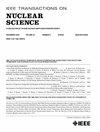Modification of the Morphology and Light-Emitting Properties of InGaAs/GaAs Uncapped Quantum Dots by γ-Irradiation
IF 1.9
3区 工程技术
Q3 ENGINEERING, ELECTRICAL & ELECTRONIC
引用次数: 0
Abstract
The influence ofγ辐照对InGaAs/GaAs非封顶量子点形貌及发光性能的影响
研究了γ辐照对生长在GaAs(100)衬底上的未封顶的InxGa1-xAs/GaAs量子点(QDs)形貌和发光特性(强度、峰位和光致发光(PL)带半宽度)的影响。辐射剂量在1 - 10亿美元千吉范围内变化。结果表明,随着辐射剂量的增加,量子点的平均尺寸增大,表面密度减小。由于低剂量效应,低剂量γ量子辐照提高了样品的发光强度。高剂量辐照下强度增加的原因是通过辐射诱导缺陷水平增强载流子从润湿层(WL)向量子点的转移。量子点发光带的光谱位置在辐照下保持不变或微弱蓝移,这可以解释为两个效应的抵消:量子点平均尺寸的增长和铟从量子点向外扩散。
本文章由计算机程序翻译,如有差异,请以英文原文为准。
求助全文
约1分钟内获得全文
求助全文
来源期刊

IEEE Transactions on Nuclear Science
工程技术-工程:电子与电气
CiteScore
3.70
自引率
27.80%
发文量
314
审稿时长
6.2 months
期刊介绍:
The IEEE Transactions on Nuclear Science is a publication of the IEEE Nuclear and Plasma Sciences Society. It is viewed as the primary source of technical information in many of the areas it covers. As judged by JCR impact factor, TNS consistently ranks in the top five journals in the category of Nuclear Science & Technology. It has one of the higher immediacy indices, indicating that the information it publishes is viewed as timely, and has a relatively long citation half-life, indicating that the published information also is viewed as valuable for a number of years.
The IEEE Transactions on Nuclear Science is published bimonthly. Its scope includes all aspects of the theory and application of nuclear science and engineering. It focuses on instrumentation for the detection and measurement of ionizing radiation; particle accelerators and their controls; nuclear medicine and its application; effects of radiation on materials, components, and systems; reactor instrumentation and controls; and measurement of radiation in space.
 求助内容:
求助内容: 应助结果提醒方式:
应助结果提醒方式:


